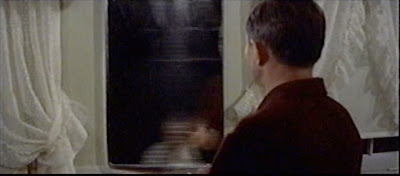The 1950s

Ignore the digital interlacing blur. The above's a momentary glimpse of DP or director Nicholas Ray as James Mason shuts a bathroom mirror in Bigger Than Life (1953). It seemed a fitting metaphor to me of the thematic complexity of the film - an undercurrent that ever since the Cahiers critics has been part of the Nicholas Ray text, but still runs against an overpowering reading formation.
Namely, the historical ethnocentrism that assumes naivete in 1950s cinema. By now, there's a range of critiques we see of 1950s domestic ideologies, especially as Hollywood trafficked in them. Some of these critiques are profound, some facile, many in between. But I think we underestimate how much Hollywood offered at least some kinds of contemporary social critique. These critiques could be distinctive (the Cahiers version suggests Ray as auteur on this basis), but the auteur production was merely one form of wider grappling with social critique. There's a larger interest I have: some scholarship on American melodrama has hinted at this (Barbara Klinger, Marianne Conroy), but the popularization of sociology forms a key thematic backbone of 1950s melodrama.
Comments